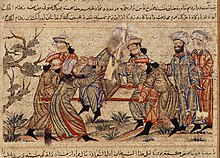Nizāmīya

Nizāmīya ( Persian نظامیه Nezamiye , Arabic نظامية Nizamiya , DMG Niẓāmīya ) is the name of a number of religious schools founded by Nizām al-Mulk (1018-1092), the vizier of the two Seljuk rulers Alp Arslan and Malik Shah in the second half of the 11th century in Iraq , the Jazīra and were founded in Persia and werereserved forscholars of the Ashʿari and Shaafiʿite orientations of Sunni Islam.
Nizāmīya system
The first of these schools was built between 1065 and 1067 according to the four- iwan plan in Baghdad, at the same time as the Hanafi madrasa at the grave of Abū Hanīfa . Other nizāmīyas followed in Nishapur , Amol , Balkh , Mosul , Herat and Merw . Nizam al-Mulk also equipped each of these teaching institutions with a library.
The scientific and cultural institutions, which are similar to today's universities, contributed to the development of Islamic culture and higher education, in particular to the spread of the Ashʿarīt and Shāfiʿite teaching. While the Ashʿarites and Shāfiʿites had previously been persecuted in the Seljuk Empire, with these schools they received official recognition and support for the first time.
Nizāmīya of Baghdad
The Nizāmīya of Baghdad was built for the Shafiite scholar Abū Ishāq al-Shīrāzī (d. 1083). Construction began in 1065 and the inauguration took place on September 22, 1067. From 1091 (= 484 of the Hijra ) al-Ghazali (1058–1111) worked at the school.
Obviously, Nizam al-Mulk planned to provide this school with a burial place analogous to the Hanafi madrasa built at the same time at the grave of Abū Hanīfa. The Egyptian historian Al-Maqrīzī reports that in 1081/82 Nizam al-Mulk entered into correspondence with his Fatimid colleague Badr al-Jamali to transfer the remains of al-Shāfidī , whose legal system was taught at the Nizamiyya, from Cairo to Baghdad to be able to transfer and accommodate in his school. However, due to protests by the population in Cairo, this transfer did not take place. So the plan didn't work out.
A famous graduate of Nezamiyeh of Baghdad was Baha 'ad-Din Ibn Schaddād (1145-1235), the military Qadi and biographer of Saladin . He worked as a repeater ( muʿīd ) at this madrasa for four years .
literature
- Asad Talas: La Madrasa Nizamiyya et son histoire. Paris: Paul Geuthner , 1939.
- Omid Safi: The Politics of Knowledge in Premodern Islam. Negotiating Ideology and Religious Inquiry. University of North Carolina Press, Chapel Hill, 2006. pp. 91-93.
supporting documents
- ↑ Cf. G. Makdisi and J. Pedersen: Art. "Madrasa" in Encyclopaedia of Islam , Vol. V, pp. 1126f
- ↑ See Safi: The politics of knowledge . 2006, p. 92.
- ↑ after Abū l-Ḥasan al-Ashʿarī ; see. sacred-texts.com: Al-Ash'arī
- ↑ See the chapter "The Persecution of the Ash'arites" in Tilman Nagel : The Fortress of Faith. Triumph and Failure of Islamic Rationalism in the 11th Century. Munich 1988. pp. 85-90.
- ↑ See H. Bowen and CE Bosworth: Art. "Nizam al-Mulk" in Encyclopaedia of Islam Second Edition. Pp. 71-72.
- ↑ See Makdisi / Pedersen 1126b
- ↑ Cf. George Makdisi: The Rise of Colleges. Institutions of Learning in Islam and the West. Edinburgh 1981. p. 303.
- ↑ Cf. al-Maqrīzī: al-Mawāʿiẓ wa-l-iʿtibār bi-ḏikr al-Ḫiṭaṭ wa-l-āṯār . 3 Vols. Cairo: Maktabat al-Madbūlī 1998. Vol. III, pp. 692f.
- ↑ Cf. Gamal el-Din el-Shayyal: Art. "Ibn Sh addād" in The Encyclopaedia of Islam. New Edition Vol. III, pp. 933b-934b. Here p. 933b.